Laser Hair Removal
At Regenesis, we offer expert laser hair removal using the Cynosure Palomar Icon laser platform, which is safe to use on all skin types including clients with darker skin tones and complexions.
Dare to be bare and enjoy smooth, sexy, hairless skin without having to wax, pluck, or shave again. Shaving regularly can be a real pain—literally. Razor burn, ingrown hairs, and constant stubble are just some of the issues both men and women face while trying to maintain smooth skin. Laser hair removal offers a more permanent solution to treating unwanted hair. Clients can eliminate unwanted facial hair and remove unwanted hair from their neck, underarms, back, chest, abdomen, legs, and bikini areas.
By eliminating ingrown hairs and razor bumps caused by shaving. unsightly blemishes and uncomfortable skin inflammation are dramatically reduced. Clients can achieve soft, stubble-free skin that feels and looks great every day, without the hassle of daily shaving sessions. Experience the increased confidence from having clean, attractive-looking skin, free of shaving rashes or five o’clock shadows.
Regenesis offers expert laser hair removal using the Cynosure Palomar Icon laser platform, an Nd Yag laser which is safe for use on all skin types including clients with darker skin tones and complexions. Dr Hudson observes most clients experience a significant and lasting decrease in hair growth following the completion of their treatment plan. At Regenesis, we provide effective and consistent results with services provided by Dr Hudson, a licensed physician with experience since 2015.

How it works
During laser hair removal, the laser emits highly concentrated columns of light energy that are absorbed by the pigment or melanin in the hair shaft. The absorption raises the temperature of the hair follicle and thermally destroys the cells responsible for regrowth. The wavelength, pulse duration and power of the light ensure damage to these cells and do not affect the remainder of the skin. Once the hair follicle has been destroyed, it will take up to a few weeks before the hair is completely gone from the hair follicles. The hair present in the hair follicle is shed within ten to fourteen days after treatment.

Hair growth occurs in three phases: Anagen is the active growth phase; Catagen is the involuting or regressing phase; and Telogen, the resting or inactive phase. Laser hair removal is only able to treat hair follicles that are in the active growth phase. Approximately 85% of hair at any one time is in the active growth phase. As a result, multiple treatment sessions are required to eliminate unwanted hair. The average hair growth cycle of a hair follicle lasts between 6 to 8 weeks. Treatments are performed every 4 to 6 weeks to allow time for hair follicles in the resting or inactive phase to convert to the active growth phase.
On average, clients experience a permanent reduction of greater than 90% of unwanted hair after 5 to 7 treatments. Clients with darker skin tones tend to require more treatment sessions since laser hair removal is performed using lower energy settings to prevent damage to their skin. Light and grey colored hair tends to be more difficult to treat, but Regenesis can treat blond, grey, and white hair using a specialized laser attachment. We recommend not treating tanned skin as skin tanned within the last 7 days is more prone to burning.
faqs
Hair within the areas being treated should be trimmed to a few millimeters above the skin surface. You can shave up to 1 to 2 days and wax no less than 7 days before your laser treatment.The laser settings used during your treatment will be adjusted according to your specific skin type and tone as well as the color, thickness, and location of the hair being treated. Most clients experience minimal pain during laser hair removal, especially when you compare it to other treatments such as waxing. Many clients describe the treatment as like the sensation of their skin being snapped by a rubber band. The area being treated, and your individual pain tolerance will dictate the pain level associated with your treatment. Depending on the size of the treatment area, a session of laser hair removal can be as little as a few minutes and require up to 30 minutes to perform.
Patients may experience slight swelling and redness within the treatment areas immediately after a laser hair removal session. This should subside within a few hours. The skin in treated areas may appear sunburned for at least a day or two following the procedure. A cold compress may be applied to the treated areas and anti-inflammatory medication may be used to relieve any discomfort. Patients should apply sunscreen and cover the areas of skin treated with protective clothing to reduce the risk of sunburn and prevent the development of color changes within the areas of skin treated. After each session, the hair in the treated area will appear finer and lighter in color. Since the heat from the laser remains in your skin for up to 24 hours, clients should avoid the gym, saunas, and hot tub following treatment to avoid the risk of developing a skin infection.
About a week following a session, patients may notice what appears to be hair regrowth, but this is actually hair shedding. You may leave the hair alone or shave at this time, but you should not wax or pluck the hairs.
Laser hair removal can be used safely to treat multiple areas of the body including the face, chin, arms, underarms, legs, abdomen, breast, buttocks, and the bikini line. Laser hair removal can also be used to treat painful, ingrown hairs.
Most patients require between 3 to 7 sessions to achieve their desired result. Dr. Hudson recommends clients schedule treatments every 4 to 6 weeks to achieve maximal permanent hair reduction. The number of sessions you require is dependent on the thickness of your hair, the treatment area, and the stage of hair growth at the time of treatment.
costs
The cost for laser hair removal varies widely, depending on the size of the area being treated, and the time required to perform the treatment.
results

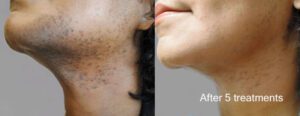
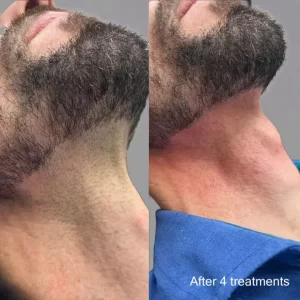
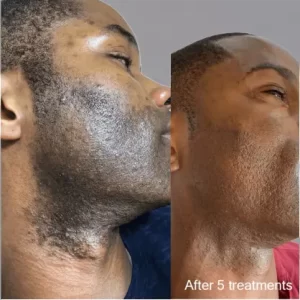
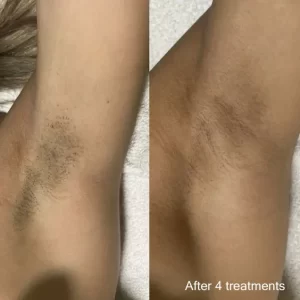
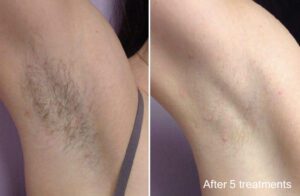
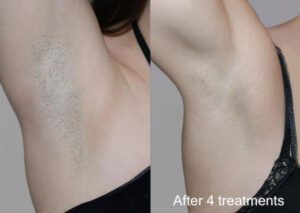
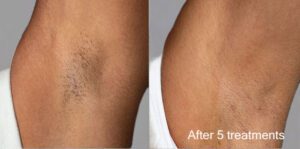
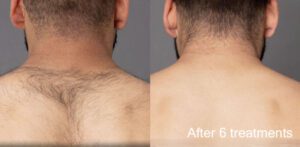
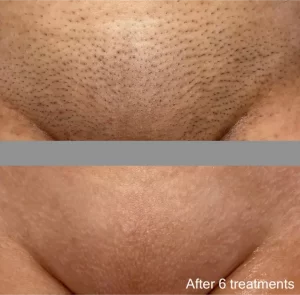
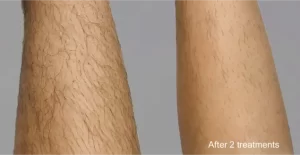
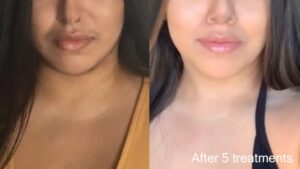
*Individual results may vary with different patient experiences.
*A series of treatments may be required for desired results.
